Great idea! No, don’t worry – rain is not a bigger issue in Ireland than in Germany (for example).
How do I know that? We run a motorbike rental company in Ireland (update: we did for a number of years) and I ride practically all year round (almost – January and February are too cold).
So, now that we have taken care of the formalities, let’s get down to business – how do you plan a motorbike trip to Ireland?
Below you will find my 56 hot tips for a wonderful motorbike holiday:
Page Contents (click line to jump the text)

1. Best season – climate, weather, traffic
As it hardly ever gets really cold in Ireland, you can ride almost all year round. From January to March, however, it’s usually quite chilly. Most Irish people ride from around April until just before Christmas.
Motorbike tourists generally visit Ireland in the months of May to September. This is when temperatures are warmest and rainfall is lowest.
2. Helmet – which is the best for Ireland?
In principle, any helmet with ECE approval will work in Ireland. If you use a jet helmet, you should have a visor that covers your whole face, otherwise it can get uncomfortable in the rain.
The flip-up helmet has proved very useful for motorbike trips, and travel enduro helmets with a visor and sunshade are also a very good choice.
3. Which motorbike suit is recommended?
In the summer months almost anything goes – textile suit with good ventilation, leather jacket and motorbike jeans or textile summer suit.
In spring and autumn, a normal textile suit with removable lining is the better choice.
If you don’t have a reliably waterproof suit, you should definitely have a separate rain suit in your luggage – according to the motto “having is better than needing”. Just like in Germany.
4 Motorcycle boots – often underestimated
I have tried rain covers for motorbike boots and am not very enthusiastic about them. Good waterproof motorbike boots are expensive, but you’ll get a lot of use out of them.
5. Motorbike gloves
I usually carry two pairs of gloves on tour: a pair of thin breathable gloves and a pair of lined ones with a waterproof membrane.
They’re good for almost any weather and you can change them if one gets wet.
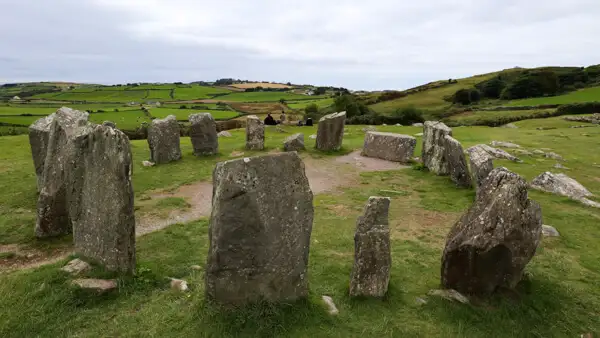
6. Little helpers
A cold neck – becomes a stiff neck – becomes a sore neck…. A good scarf or, if it gets chilly, a windproof collar, will help. A kidney belt should also always be taken along.
7. Rain suit – better to have than to need
Exactly, most supposedly waterproof motorbike suits don’t deliver what they promise – namely waterproof. And if they do, it’s usually over after a few summers. A rain suit doesn’t cost much and keeps you dry and warm.
8. Best bike for ireland
In Ireland, the roads are often narrow and rather confusing due to hedges and walls. The pace of travel is therefore rather slow. The quality of the roads is often “bumpy” and rolled chippings are often used in road construction and left lying around. Parking spaces at the roadside are often only gravelled.
All this is no problem if you ride a light or medium-weight motorbike. You should have your feet well on the ground to be able to manoeuvre or turn around easily. A light or medium weight touring enduro is a very good choice.
But the cruiser or sport bike will work too, of course. After all, if the road gets bumpy and the tight suspension tortures your back, you can slow down.
But if you’re going to ride a fat one, you should be able to handle it well, especially at slow speeds, when turning around, or in narrow passages.
If you drive a motorbike with over 100 hp, you can safely throttle it down to 48 hp – that’s all you need in Ireland 🙂
Yes, I was only joking…
9. Recommended attachments
The foot slips when manoeuvring, the car can’t be held. All not so bad, only the clutch lever is broken off….and now?
Crash bars are always a good choice when travelling. From my point of view, the most important one is the hand guard. Pure plastic shells are only a windbreak. In the event of a fall, they do not protect the hand levers. I therefore recommend metal handguards with an additional plastic shell for wind and weather protection.
Also recommended are side crash bars that protect the engine and tank in the event of a fall.
10. Choice of tyres
The choice of tyres is, of course, strongly dictated by the type of motorbike. But whatever motorbike you ride, you can choose a good touring tyre with balanced performance on wet and dry roads.
A slightly coarser tread will help if rolling gravel or dirt makes the road slippery. If you ride a touring enduro, an 80/20 tyre is a good choice.
11. Puncture kit
A puncture is less rare in Ireland than you might think. It is therefore a good idea to carry a puncture kit for tubeless tyres, or a puncture spray for tubed tyres.
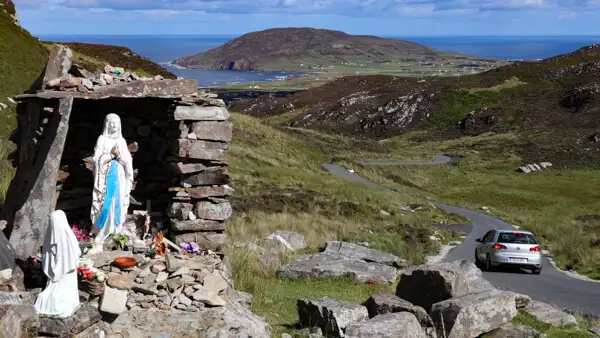
12. Chain maintenance on the road
If you ride with a cardan or toothed belt, you can skip this point. All chain riders should have a chain spray and, depending on the length of the tour, the necessary tools to adjust the chain on the way.
13. tools on the road
A few cable ties and duct tape help to fix loose parts, a few spanners for chain adjustment and the loose mirror are also handy on the road.
What happens if the plastic case no longer holds on to the carrier (it falls over)? Then a few tension straps or a piece of rope will help to fix it in place.
14. Luggage system
Scholars argue about the best luggage system: aluminium suitcases, plastic suitcases or soft luggage? Take what you like, everything works. The luggage should be waterproof. If not, you can also pack the contents in foil bags or inexpensive packing bags.
My tip for safety: Many people like to use the top case and tank bag, but not the side cases. But: Panniers or side panniers protect your leg and also your motorbike in the event of an overturn! In addition, the centre of gravity is lower with side panniers or side bags, which has the effect of more stability in riding behaviour.
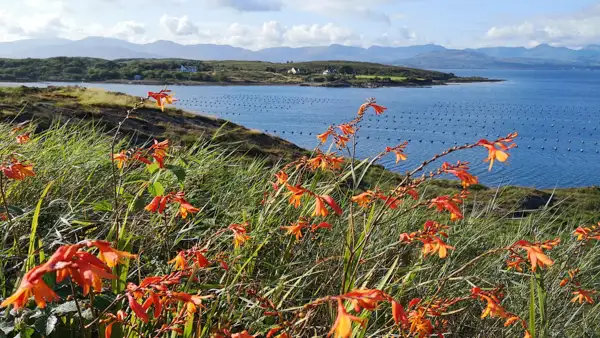
15. Navigation – with what?
There are smartphone holders for the handlebars. However, smartphones are not made for constant shocks and vibrations, heavy rain and insect bombardment. Besides, have you ever touched your smartphone after 30 minutes of navigation? These things get hot!!!
I can only recommend a motorbike navigation device with a suitable holder. The mount also supplies the navigation device with power and keeps it constantly charged. The navigation devices can’t really do more than navigation, but that’s what they’re made for. They are robust and waterproof in all conditions of a motorbike trip.
If you love maps, you can of course bring them along. I like to use them for trip planning, in addition to Google Maps, but for navigation on the road I have a sat nav on the handlebars.
16. Documents for entry
Ireland is in the EU and German citizens can enter with their passport or identity card. For the vehicle, of course, the vehicle registration document must be carried and the valid driving licence. The German driving licence is sufficient, an international driving licence is not necessary.
If you want to travel to Northern Ireland, you must take your passport with you, as Northern Ireland is part of Great Britain and has not been in the EU since Brexit.
17. Motorcycle insurance
Before setting off, check whether your German motorbike insurance covers trips to the countries you are visiting. Depending on the itinerary, this may also include transit countries.
It is also helpful to have a foreign insurance policy, such as the one offered by the ADAC. You can also take out such a policy before your trip.
If you rent a motorbike in Ireland, pay attention to the rental conditions, the amount of the deposit and the type of insurance you take out. Often there is only third party insurance and you have to pay extra for fully comprehensive insurance. With our motorbike rental, fully comprehensive insurance is included – take a look: www.easycruiser.tours.
18. Travel insurance
If you’ve ever had to cancel an expensive holiday at short notice, you’ll appreciate travel cancellation insurance. Depending on the scope, travel insurance packages may also include foreign health cover, accident insurance and travel repatriation.
Many insurance companies offer such travel insurance, just have a look around.
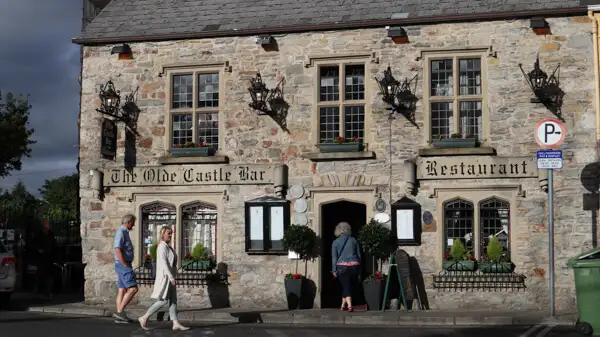
19 Currency, money and cards
Ireland is in the EU and the currency is the euro. German debit and credit cards usually work without any problems. Cash is available from ATMs at any BAnk, or as cash-back when shopping at supermarkets and many other shops.
Northern Ireland is part of Great Britain and the currency is the pound. Cash cards also work in hotels, supermarkets, petrol stations and ATMs.
20 Electricity, chargers and adapters
Ireland and Northern Ireland have 230V alternating current, so you can use German electrical appliances there without any problems. However, the plug is the three-pin English plug. Adapters are available at home from Media Markt, Amazon, at the airport, or at some hardware stores in Ireland.
21. Permitted speeds
The following speed limits apply in Ireland:
Towns50 km/hLocal and Regional Rural Roads (L,R)80 km/hNational Roads (N)100 km/hMotorways (M)120 km/h.
In Northern Ireland, as in the rest of Great Britain, speeds are measured in miles per hour. One British land mile is equal to 1.60934 kilometres. In the table below I have converted the speeds to KM/H:
Towns30 mph48 km/hCountry roads60 mph96 km/hHighway70 mph112 km/h.
22. Left-hand traffic
In Ireland you drive on the left, just like in Northern Ireland, England or Scotland. This means driving in the left lane and overtaking in the right lane.
Roundabouts are driven through in a clockwise direction. Traffic in the roundabout has the right of way over traffic entering the roundabout.
If kerbs are marked with yellow lines, parking is prohibited (one line) or stopping is prohibited (double line).
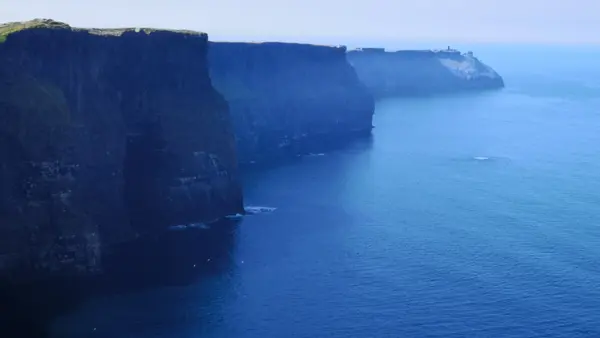
On the motorway, you enter from the left and exit to the left.
By the way, it is much easier to drive on the left with a motorbike than with a rental car, because all the controls are in the usual place. With a rental car, you sit on the right and change gears with your left hand.
Also, the narrow roads in Ireland always feel too narrow at first with a car, especially when the oncoming tractor protrudes over the centre line in a tight bend, it can quickly get tight. With a motorbike there is always enough space. It is important to always keep a good safety distance from the centre line.
23. Arriving by ferry via England
If you are travelling from northern Germany, you can take a ferry from Amsterdam or Bruges to Hull in north-east England. The ferry sails overnight and you book a cabin. The next day you cross England and take one of the ferries from Holyhead to Dublin.
24. Arrival by ferry via Scotland
A very nice alternative is to travel via southern Scotland to Northern Ireland. From Hull you travel to Cairnryan. There you can either take the ferry to Larne or the ferry to Belfast. This is also the shortest connection between the islands.
25. Arrival by ferry via France
If you are coming from southern Germany or the Alps, it is a good idea to travel to Normandy in France. I would not drive through Paris, but via Amiens and LeHavre.
The drive is long, but the northern French motorways are usually not too crowded and easy to drive. From Cherbourg, take one of the overnight ferries to Rosslare or Dublin.
26. Arrival by plane
This is certainly the cheapest and fastest option. From many German airports you can find cheap flights that land in Dublin after hardly more than 2 hours.
27. Rent a motorbike in Ireland
You can rent a motorbike in Ireland and Northern Ireland from the following providers:
www.celticrider.ie, Naas, south-west of Dublin, BMW, Can-Am
www.lemonrockbiketours.com, Trim, north-west of Dublin, BMW, Suzuki, HD
www.flyrideireland.com, Lisburn, west of Belfast, Northern Ireland, Honda
www.retroventuresireland.com, Südwestlich from Limerick (Shannon Airport), Royal Enfield
28. Road conditions in Ireland
In Ireland, the motorways (Motorway, M) are mostly excellent – but boring to drive. There are also not very many and most lead to Dublin in a star shape.
National Roads (N) are roughly equivalent to German country roads. They are usually easy to drive and connect the smaller towns with each other.
The most scenic roads are usually Regional Roads (R) or Local Roads (L). They are often narrow, lined with hedges or walls and often “bumpy”. The road surface is sometimes good and sometimes not. Road construction often uses rolled chippings, which then remain on the road for ages, and agriculture sometimes carries mud onto the road. The only thing that helps here is to drive slowly and carefully.
29. How much distance can you cover?
Because of the road conditions, average cruising speeds are much lower than most motorcyclists would expect. Our guests (motorbike rental: www.easycruiser.tours) hardly ride 250 kilometres per day on average. Sometimes more – but sometimes less.
Of course, the beautiful landscape, especially along the Wild Atlantic Way, also slows you down – if you have to take photos all the time, you hardly get anywhere :-).
30. Visit Dublin
It makes a lot of sense to spend a night in Dublin at the end of the trip. The centre is more or less around Templebar, is of course touristy, but also really nice to visit with lots of sights and a lively nightlife.
Why at the end of the tour? So you don’t have to carry your shopping around all the time!
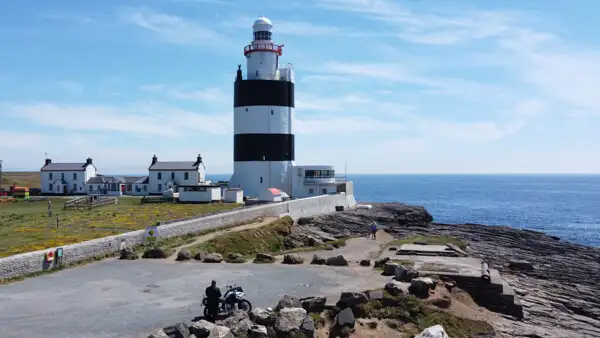
31. Ireland`s Ancient East
Ireland has a rich and turbulent history. It was particularly rich and turbulent in the east of the country, in a wide arc around Dublin called the Pale. Here you will find plenty of castles and stately homes with wonderful parks, old battlefields, medieval monasteries and Celtic holy sites.
32. Ireland`s Sunny South East
The south east has the lowest rainfall and highest temperatures in Ireland. South of Dublin there are over 70km of beautiful sandy beaches stretching all the way to Wexford. This is where Dublin families and their children like to spend their summer holidays. I admit that the Wild Atlantic Way is more spectacular, but the coasts from Wicklow to Wexford to Waterford also have their charms.
33. The Southern Wild Atlantic Way
Kinsale, south of Cork, is the southern starting point of the 2500km Wild Atlantic Way. From here you follow the coast to Baltimore and Mizen Head in the southwest and get a first impression of the rough Atlantic.
The peninsulas of the southwest, Beara, Iveragh and Dingle, are really beautiful. You will then reach Galway via the Cliffs of Moher and the Burren and have driven about half the WAW. You should plan a good week for this.
34. The Northern Wild Atlantic Way
From Galway, through Connemara and Mayo to Westport, then across Achill Island and the west coast to Sligo and on to Donegal. Cross the cliffs of Slieve League to Glenveagh National Park and the north coast to Fanad Head and Malin Head.
There you will reach the northern starting point of the Wild Atlantic Way. You can continue through Northern Ireland, or head straight back towards Dublin. You should also allow a good week for the northern WAW.
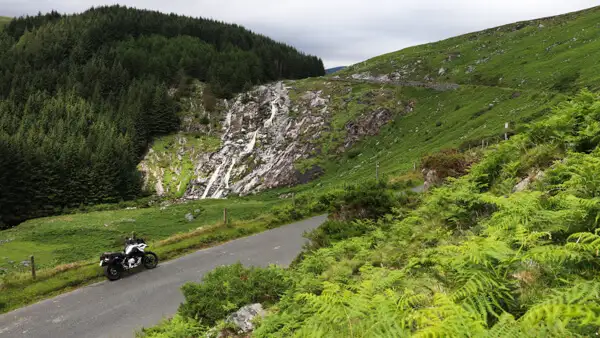
35. The Midlands
The middle of Ireland is less spectacular than the west coast, but can also be very pretty. Along the Shannon you will find many beautiful lakes and nice towns like Carrick-on-Shannon.
Away from the tourist crowds, the original Ireland finds its space: pretty little towns, rolling hills and small winding roads make the drive through the hinterland entertaining.
36. Northern Ireland
Northern Ireland is also worth a diversion: The cities of Londonderry and Belfast are quite interesting to visit and the Causeway and especially the North Antrim Coastal Road are scenic to drive.
37. Accommodation – what options?
On the islands, the traditional B&B is a nice way to stay. Often plushly furnished and lovingly run, B&Bs are certainly more personal than hotels. Here you get sumptuous meals (for breakfast!!!) and lots of good advice and tips from the dedicated owners. Otherwise, there are also hotels, homestays, hostels and campsites of all kinds.
38. Booking accommodation
With a booking app, like booking.com or airbnb.com, you’re well equipped to make reservations. It can get crowded on the coast in the summer months, so be sure to pre-book your accommodation then.
39. Worth seeing: Irish castles
Every village has a castle – not quite, but there are many. Often the castle is just a dilapidated square tower, and sometimes it is a fortress or a magnificent castle. It’s definitely worth visiting one or two castles along the way. You can research the following tips online: Bunratty Castle, Cahir Caste, Kilkenny Castle, Blarney Castle, King John`s Castle, and Cashel Rock.
40. Colourful small towns
In Ireland’s small towns, shop entrances are often decorated with carved wooden frames, which are also often brightly painted. The houses are also often colourfully painted.
There are also hanging baskets with flowers and many flowerbeds. Rolling through a small Irish town in summer is often a very colourful pleasure!
41. Rustic pubs
I don’t think I need to explain this point: Irish pubs are known worldwide for their cosiness, good food, good music and good humour!
42. Enjoy Irish music Life
Life music in the pub often starts later in the evening, so if the landlord is talking about 21:00, I wouldn’t expect it until 22:00 – but then it takes off! The Irish love their music and the musicians are passionate about it!
43. Cultural things
If you’re not averse to cultural things besides motorcycling, Dublin has plenty of museums, galleries, exhibitions, art and music events.
So why not combine your motorbike trip and subsequent stay in Dublin with a visit to a museum and an Irish poetry reading or musical in the evening?
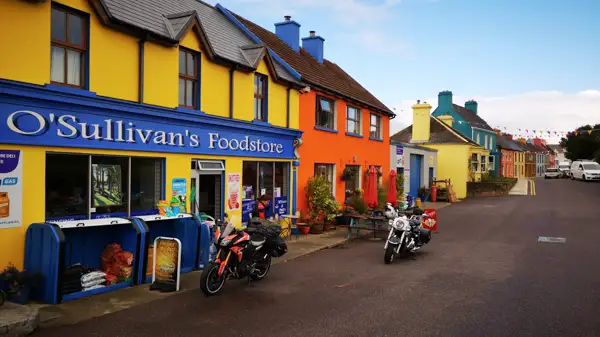
44. Festivals
During the summer months, numerous festivals take place all over the island. These are often agricultural open-air events, there are horse markets, theatre festivals, music festivals and food festivals, such as the famous Oyster Festival in Galway in September.
45. Irish Heritage
The Irish are now proud of their chequered history. This was not always the case, as until the 1960s the country was one of the poorest in Europe. With the extremely positive development of the last decades, self-confidence has also grown and so today there are many places where Irish history can be experienced in a wonderfully vivid way. Fine examples are the small, beautiful museum village of Glencolumbkille, the Heritage Park in Wexford, the Muckross Traditional Farms near Killarney or the museum ship Dunbrody in New Ross.
46. Sporting Activities
You can ride a motorbike only, or go surfing, kite surfing, scuba diving, sailing, swimming, hill walking, deep sea fishing, hiking, camping, canoeing, trail riding, cycling, mountain biking and much more!
Are you sporty? You might find a nice activity in Ireland to extend your holiday.
47. Boat trips
Ireland is not only one big island, but there are also many wild and romantic little islands off the coast! You can often visit these with small ferries or excursion boats.
A prominent example is Skellig Michael, which you can reach from Portmagee. There you can admire hundreds of thousands of colourful puffins in summer and St. Fionan`s Monastery, a picturesque monastery from the Middle Ages. It has been used as the setting for Star Wars. There are many more islands to visit as well.
There are also many whales, dolphins, seals and other sea creatures to admire on the Irish coast. The best way to do this is on a whale-watching boat trip.
48. Great food
Traditional Irish food is hearty and filling! There are the best steaks, wonderful fish, delicate oysters and mussels and numerous hearty stews and casseroles. Follow it up with one of the wonderful homemade desserts to finish and then you can roll straight into bed!
49. What to drink in Ireland?
Dark, heavy beer is called stout – there are other brands besides Guiness. Ale is a light beer, red ale is reddish. There are also numerous export beers and also non-alcoholic beers.
You can also taste several types of Irish whiskey. Besides Bushmills and Tullamore Dew, there are many others, also from smaller, lesser-known distilleries.
Cider is less common in Germany, but popular on the islands. It probably corresponds most closely to the French cider, a fermented apple cider.
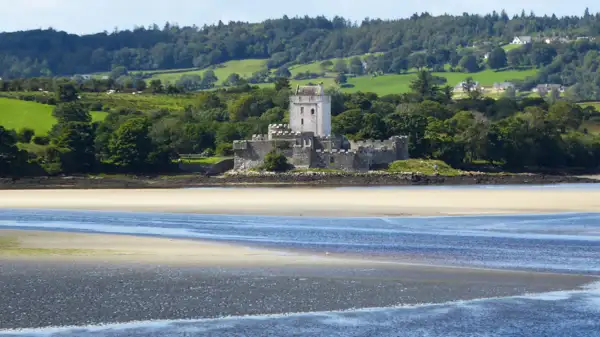
50. Motorcycle Festival in Killarney
Yes, there is also a small motorbike festival in Ireland, held every June in Killarney. You can find out more at: www.irelandbikesfest.com.
51. Distinguished Gentlemens Rides
A particularly nice motorbike event is the Distinguished Gentlemen’s Ride, which impresses not only with its dignified costumes but also with its charitable purpose. It is also held in Ireland every year. Dates can be found at: www.gentlemensride.com.
52. TT Races on the Isle of Man
What motorbike racing fan wouldn’t want to visit the Tourist Trophy on the Isle of Man? But then you have to get up early or book early. Tickets, ferry and accommodation should be booked at least two years in advance.
54. The Northwest200 Races
The Northwest200 race in Northern Ireland is a road race similar to the Isle of Man TT – and similarly dangerous. Information can be found at: www.northwest200.org
55. Cities worth seeing
Ireland and Northern Ireland have a number of interesting and pretty cities. You can spend a double night there and at least do a little sightseeing on one of the days. Some good examples are: Kilkenny, Killarney, Limerick, Galway, Londonderry, Belfast and Dublin.
56. Souvenir Shopping
If you go for a stroll in Dublin on your last day, you are sure to find one or two typical Irish souvenirs: Celtic jewellery, Irish whiskey, a woollen jumper from the Aran Islands, a T-shirt or hoody printed with Irish motifs, Irish sweets or one of the many Guinness souvenirs – you are sure to find something that will remind you at home of your wonderful trip to Ireland.
Conclusion
So, you’ve read 56 tips for your motorbike trip in Ireland – do you feel better informed now?
I hope so!
Now there is only one thing left to do – to put your plans into action.
So, when will you come to Ireland?
More interesting articles for you
PREPARING FOR A MOTORBIKE TRIP IN IRELAND – CHOOSING A ROUTE AND NAVIGATION
MOTORBIKE TRIP IRELAND – WHICH REGION SHOULD I GO TO?
I’M PACKING MY BAGS AND TAKING… THE PACKING LIST FOR YOUR MOTORBIKE TRIP TO IRELAND!
LEFT-HAND TRAFFIC – WHAT SHOULD I KNOW AS A MOTORCYCLIST?
Photo credits cover photo: Motorbike in little fishing harbour, photo by Ulrich Knüppel-Gertberg (www.irland-insider.de, www.ireland-insider.com)